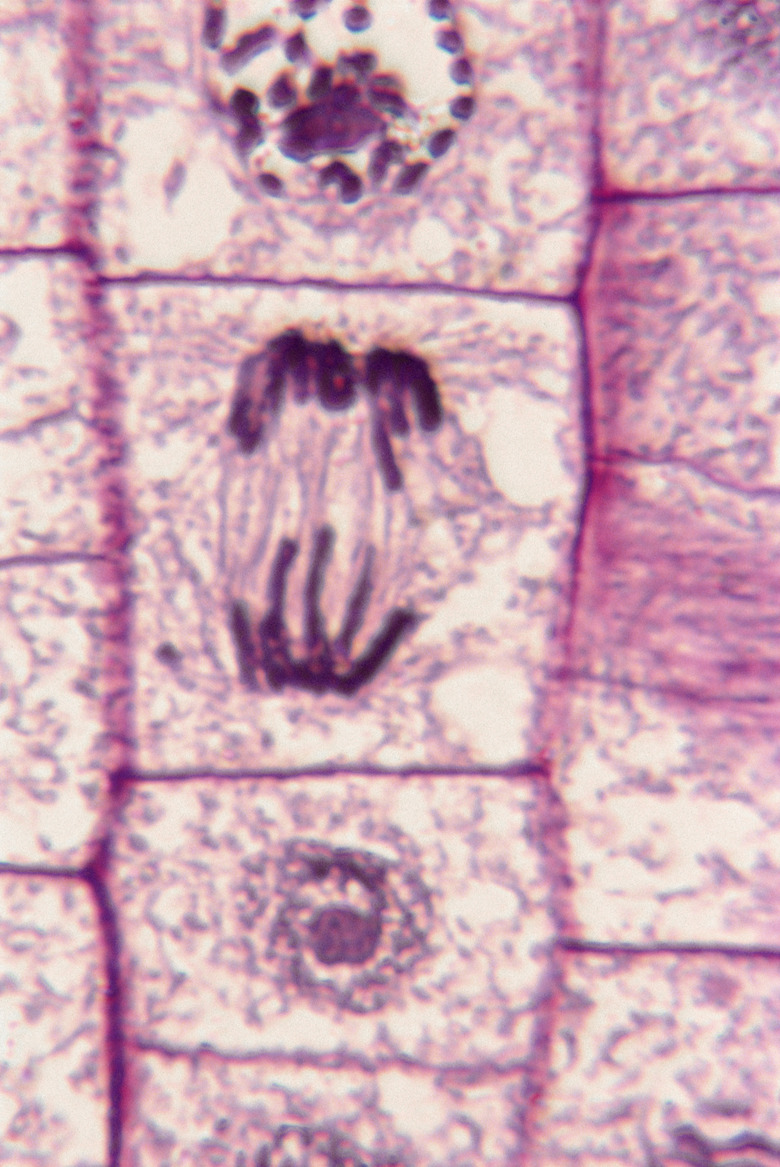What Is The Goal Of Mitosis?
The human body possesses about 37.2 trillion cells, all of which developed from a single fertilized egg. Mitosis, one of the two main processes of cell division, occurs both during development and also throughout a lifetime, as old cells are replaced by new ones.
Each of the different types of cells in the body has a different lifespan. For example, red blood cells live about a month and white blood cells live more than a year, while skin cells live for only a few weeks. This makes it necessary for cells to replicate, or create replacement cells, on a regular basis.
TL;DR (Too Long; Didn't Read)
The goal of mitosis is to divide a cell to produce two cells, each of which is identical to the parent cell.
The cell cycle is the process by which cells multiply, which is necessary for an organism to survive. Bacteria, like other prokaryotic cells, multiply through **binary fission**, but in cells with a nucleus, like those in humans and animals, replication happens through mitosis or meiosis.
Mitosis vs. Meiosis
Mitosis vs. Meiosis
Mitosis results in identical cells. Though cells may differ from one part of the body to another, it is important for cells of the same type to be identical in order for them to function properly as a whole. New cells are constantly produced to replace the ones in our bodies that die each day.
In meiosis, diploid cells split into two cell and then again with an end result of four haploid cells. The new cells receive only one copy of each chromosome rather than two and have only half the number of chromosomes as the parent cell.
In humans, the special haploid cells called gametes produced during meiosis are called eggs (female) or sperm (male). When these cells combine, they produce a new cell that shares parts of each of its parent cells.
Only Mitosis Produces Identical Cells
Only Mitosis Produces Identical Cells
The purpose of mitosis is to divide one cell in such a way that two "daughter" cells are genetically identical. There are five phases of mitosis:
1. Prophase 2. Prometaphase 3. Petaphase 4. Anaphase 5. Telophase and Cytokinesis
(Some sources may omit prometaphase when describing mitosis.)
The main goal of mitosis is to line up duplicated chromosomes and to split them equally, resulting in two cells with the same number of chromosomes.
During prophase, at the beginning of mitosis, chromosomes condense, becoming shorter and thicker, and create sister _chromatids_, which are two identical parts connected at the centromere. Once they have replicated, the nucleus dissolves and the chromosomes move to the center of the cell. The mitotic spindle pulls the two apart, creating twin daughter cells that are each an exact copy of the mother cell.
Then metaphase begins, and the replicated chromosomes move to the outer part of each cell. In anaphase, the chromatids begin to move away from each other, becoming individual chromosomes. When they stop moving, telophase begins; a nuclear envelope forms around each set of chromosomes, and they become separated by newly formed cell membranes.
The goal of mitosis has been reached: two identical cells have formed. Since each has two copies of each chromosome, the process can repeat, allowing body cells to renew themselves.
When Mitosis Goes Wrong
When Mitosis Goes Wrong
In many cases when the mitotic process fails, the abnormal cell dies. In a growing embryo, if the chromosomes are damaged or fail to separate, genetic anomalies may occur, some of which can result in a stillbirth or miscarriage. In the event a live birth occurs, conditions such as lymphoma, leukemia, Down syndrome and other conditions may result.
If the process fails in a fully formed human body, and damaged cells continue to replicate, these cells have the potential to cause the development of a tumor or cancer.
Cite This Article
MLA
Yavorski, Kimberly. "What Is The Goal Of Mitosis?" sciencing.com, https://www.sciencing.com/goal-mitosis-9438/. 22 March 2019.
APA
Yavorski, Kimberly. (2019, March 22). What Is The Goal Of Mitosis?. sciencing.com. Retrieved from https://www.sciencing.com/goal-mitosis-9438/
Chicago
Yavorski, Kimberly. What Is The Goal Of Mitosis? last modified March 24, 2022. https://www.sciencing.com/goal-mitosis-9438/
